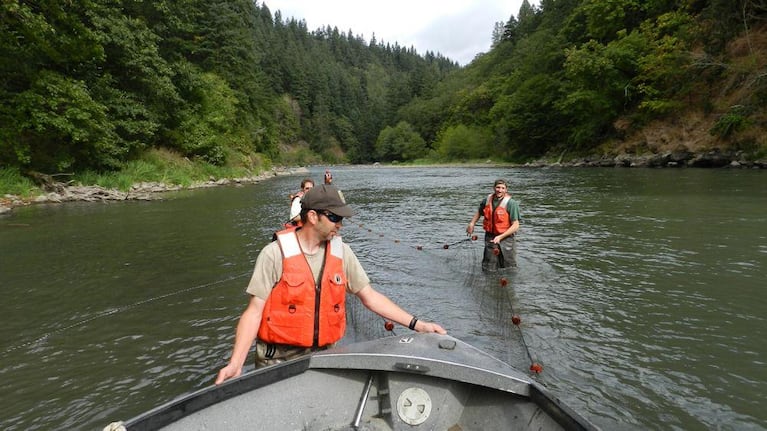
Biologists tighten a 200 foot long delicate seine net to encircle spawning chinook. They are trapping the salmon and moving them upriver to ensure their eggs aren't suffocated by sediment released when the Condit Dam is breached in October.
Amelia Templeton
HUSUM, Wash. -- Scott Ellsworth has spent the last week babysitting a nest of chinook salmon eggs.
A female salmon dug with her tail into gravel bed of the White Salmon River a few yards away from cabin number six, where Ellsworth lives. He watched from his porch as a handful of snaggle-toothed males hung around, hoping to be the one to fertilize her eggs.
When the fry from this nest, or redd, emerge in the spring, they will be part of the first generation of threatened chinook to colonize eight new miles of new habitat opened up on this Columbia River tributary by the removal of the Condit Dam. The female salmon is dying now, and Ellsworth is chasing rafters and reporters away from the gravel bed where she laid her eggs.
“I like the thought that I can boat all the way down to the Columbia, and while I do it, the fish will be coming the other way up here and spawning in grounds they haven’t seen in a hundred years,” Ellsworth says.
Biologist Rod Engle with the U.S. Fish and Wildlife Service has also been monitoring this redd. Lower Columbia fall chinook, called tules, are a threatened species, and the U.S. Fish and Wildlife Service is trying to ensure this population doesn't lay its eggs in the path of 2.7 million tons of sediment that will be released when the Condit Dam is breached on Oct. 26.
Engle and a handful of other federal and tribal biologists are trapping feisty, 40 pound fall Chinook in a deep pool a few miles from the mouth of the White Salmon River and using a truck to move them to sites upstream of the Condit Dam.
“That sediment is going to come down the river in the next several years,” Engle says. “We’re trying to gather those fish before they can set up shop and mate. We want to put at least 500 up above the dam."
About 140,000 fall chinook salmon used to spawn in the lower reaches of the Columbia River below Ceilio Falls. Habitat loss due to dam construction, development along watersheds, irrigation diversions, and other pressures have reduced the wild Lower Columbia fall chinook population to about 6,500, according to the Lower Columbia Fish Recovery Board.
Engle says there is now little habitat available to the fall chinook that once spawned in the Columbia River Gorge. When Bonneville Dam was completed in 1938, it inundated shallow spawning grounds for fall chinook that had once existed on the banks of the main stem of the river, making spawning sites on tributaries like the White Salmon even more critical to the species' survival.
It's impossible to say exactly if the fish Engle and his colleagues are transporting above the dam are a wild stock. In 1901, the U.S. Fish and Wildlife Service established a hatchery at Spring Creek, using the eggs from wild adults captured on the White Salmon River. For more than a hundred years, that hatchery has bred millions of fall chinook salmon, preserving a genetically unique strain of fish, most of which return to the hatchery to spawn. In 2008, biologist learned that a genetically identical population was spawning at the mouth of the White Salmon River, just below the Condit Dam. Hatchery fish can now be identified by their clipped fins, but the two populations may have been interbreeding for years.
Engle says he expects to see other species of fish benefit even more from the removal of the Condit Dam in October. Thirty-three miles of the White Salmon will be opened up for steelhead, and 21 miles will be available for coho.







